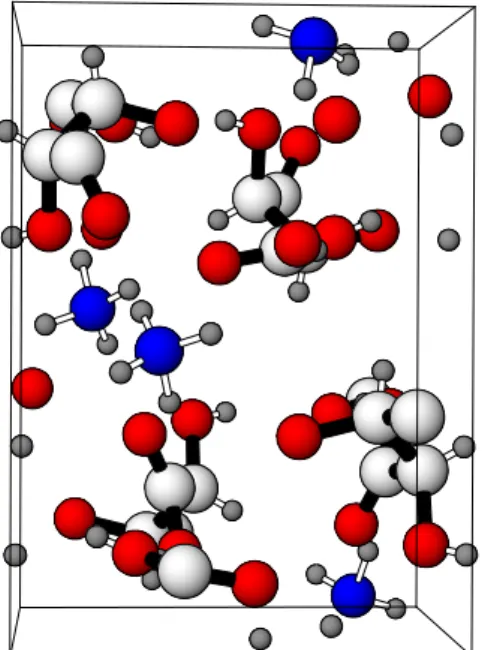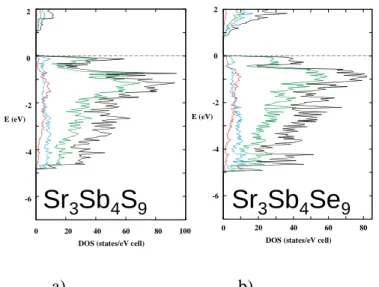行政院國家科學委員會專題研究計畫 期中進度報告
具已知構造單元的新穎金屬固態化合物之合成與鑑定(1/3)
計畫類別: 個別型計畫 計畫編號: NSC91-2119-M-009-001-執行期間: 91 年 10 月 01 日至 92 年 07 月 31 日 執行單位: 國立交通大學應用化學系 計畫主持人: 李積琛 計畫參與人員: 王明芳, 曾翊媚, 吳明誠, 陳怡如 報告類型: 精簡報告 處理方式: 本計畫可公開查詢中
華
民
國 92 年 5 月 28 日
行政院國家科學委員會補助專題研究計畫
□成果報
告 期
中進度
報
告
具已知構造單元的新穎金屬固態化合物之合成
與鑑定
計畫類別:
個別型計畫
□ 整合型計畫
計畫編號:NSC91-2119-M-009-001-
執行期間: 91 年 10 月 1 日至 92 年 7 月
31 日
計畫主持人:李積琛
共同主持人:
計畫參與人員: 王明芳,曾翊媚, 吳明誠, 陳怡如
成果報告類型(依經費核定清單規定繳交): 精簡報告 □完整報
告
本成果報告包括以下應繳交之附件:
□赴國外出差或研習心得報告一份
□赴大陸地區出差或研習心得報告一份
□出席國際學術會議心得報告及發表之論文各一份
□國際合作研究計畫國外研究報告書一份
處理方式:除產學合作研究計畫、提升產業技術及人才培育研究
計畫、列管計畫及下列情形者外,得立即公開查詢
□涉及專利或其他智慧財產權,□一年□二年後可公開
查詢
執行單位:
中 華 民 國 92 年
5 月
30 日
行政院國家科學委員會補助專題研究計畫
期中進度報告
具已知構造單元的新穎金屬固態化合物之合成與鑑定
Synthesis of New Solid-State Compounds der ived fr om Zintl
Ions
計畫類別:
個別型計畫
□ 整合型計畫
計畫編號:NSC91-2119-M-009-001-
執行期間:91 年 10 月 1 日至 92 年 7 月 31 日
計畫主持人:李積琛 交通大學應用化學系
(一)中英文摘要 本計畫是為期三年新進人員國科會計畫之第一年執行結果摘要。這一年主要的工 作在建立一固態材料化學實驗室。在實驗器材上,主要的研究工具包括無氧無水 手套箱,高真空系統,高溫金屬熔煉爐,高溫爐,與相關的元素化學品均已準備完 成。接下來將可進行有系統的合成具有已知構造單元或已知 2 維或 3 維結構之新 固態化合物(Zintl Phase)。在分析工具上,x光單晶繞射儀(Nonius CAD4)已架設完 成並測試完畢,X 光粉末繞射儀與熱電分析儀將於近日完成安裝與測試。這些儀 器將對材料的其結構,物理與化學性質的解析有很大的幫助。在理論計算的工具 上,三套固態化合物的電子組態理論計算的套裝軟體(LMTO 4.7c, YaEHMOP 與 Wien2000 V03)已安裝於一臺 CPU(PIII 1.4 GHz x2) Linux 工作站並已對一些已 知固態化合物的理論電子組態計算做測試運算.在晶體結構的分析工具上,包括單 晶結構解析(Shelxs Windows, Crystal2000, Jana2000),粉末繞射數據分析(GSAS, Cellref3, Fulprof2000)與結構輸出等軟體均已安裝並可使用.Abstr act
This report is for the first year progress of the three year project supported by National Science Council (NSC). The major contribution for this year is to set up a lab for research on the solid state materials. For the lab facilities, the major tools including glove box (for sample preparation), high vacuum system (to seal reaction tube), Arc melt machine (for high temperature reaction), high temperature furnace (for sample reaction) and chemicals for solid state reactions are ready to use for experiments for syntheses of new solid state compounds from starting materials with known building units. For the characterization tools, a single crystal X-ray diffractometer (Nonius CAD4) has been installed and tested. A powder x-ray diffractometer and a Seebeck coefficient measurement system are going to be installed soon. These instruments would be useful for structural and physical property analyses of materials. For electronic structure calculation, three software packages, LMTO 4.7c, YaEHMOP and Wien2k V03, have been installed in a two CPU Linux workstation and have been tested on some known solid state compounds. Essential tools for general analyses of single crystal and powder x-ray diffraction data, including Shelxs Windos, Crystal2000, Jana2000, GSAS, Cellref3, Fulprof2000 and Atoms 5.1 for crystal structure presenting tools were installed and ready to use.
(二)計畫緣由與目的
Scientists have discovered the compositions and often the structures of more than 20 million different materials.1 Among these materials, only small portions (less than 1% of the total) of them are inorganic and exhibit three-dimensional (3D) structures. Some of these inorganic compounds are the essential materials for modern technologies including ceramics, metals and their alloys, and semiconductors.2 Nonetheless, future technology still needs new materials for applications such as catalysts, sensors, thermoelectric materials, superconductors, and batteries, to name a few. The development of these technologically relevant materials relies on persistent research in finding new materials, not only to optimize the desired properties but also to produce technological breakthroughs. In recent years, investigations in nanometer size particles (quantum dot) and wires (nanowires) have been intensively pursued because of their interesting physical properties and their applications in many fields.3,4 However, the ability to synthesize nanometer-scale materials with controllable size remains a challenge to chemist. For a solid-state chemist point of view, near isolate fragments of metal clusters, chains and sheets exist in many inorganic compounds.
The investigations of solid-state compounds with the building units of clusters could lead a new direction for synthesis new nanometer-scale materials.
The goal of this project is to explore new pathways in the synthesis of new solid-state compounds by using the flux growth method. Zintl phases (binary or ternary) and compounds with metal fragments (ions, clusters or polymeric forms) will be used as the starting materials to study the relationship between structure and the size of initial building blocks, structure of the final product, the effect of flux material, reaction temperature, and electronic structure within a class of compounds containing fragments of Zintl ions and metal clusters. For this project, I will focus on the reaction between Zintl compounds with isolated main group clusters and compounds with metal clusters. The detailed goals of this project include:
1) Synthesis and physical characterization of novel compounds containing Zintl ions and transition metal clusters.
2) Synthesis and physical characterization of novel compounds of quaternary alkaline earth systems (Ae- TM - Q - X; A = alkali or alkaline earth elements; TM = transition metal; Q = group 14 – 16 elements; X = S, Se).
In the past 10 months, the major goal for this project is to set up a solid state research lab that not only can do synthesis of new solid state compound but also can characterize structure and physical properties of solid state compounds. The research facilities for solid state materials require 1) Synthetic tools: including glove box for sample preparation, vacuum system for sample manipulation, and high temperature finance for reaction. 2) Characterization tools: Structural studies (single and powder x-ray diffractometer) and physical properties measurements (conductivity, thermopower etc.). 3) Theoretical investigation tools: Band structure calculation software. At this point, nearly 90% of the lab equipments are installed and ready for research.
(三)現階段進度與結果
A) Facilities for synthesis of solid state compounds
1) Glove box: a glove box has been installed in the lab and it is ready for sample preparation. The glove box contains two pairs of rubber glove that can provide two people working at the same time. The glove box is filled with Argon gas and the oxygen/water can be removed by the catalyst built in. The Argon gas is circulating to the catalyst chamber all the time to keep the O2/H2O concentration less than ~10 ppm.
Due to the budget limit, the O2/H2O sensor did not include in this system. Instead, a
tungsten wire lamp (60W at 50V) and phosphors pentaoxide (P2O5) were used as the
lamp can last at least 14 days and the P2O5 disk shows no sign of water contamination.
The results for these chemical sensors indicate that the O2/H2O concentration in the
glove box is less than 10 ppm, which is acceptable for air sensitive sample preparation.
2) Vacuum system: A simple vacuum system is installed on the lab bench. The vacuum system will be used for sample preparation under high vacuum (~ 10-3 mbar). A trap was also included between the vacuum pump and the connector to trap impurities and vaporized samples.
3) Arc melter: An arc melting machine is installed in the lab for high temperature reaction (~2000 °C) as well as for seal metal reaction tube such as Ta and Nb tubing. 4) High temperature furnaces: Ten furnaces with different working temperature and functions (five programmable and five single point furnaces) are installed and tested in the lab. These furnaces will be used for solid state and hydrothermal reactions.
B) Facilities for str ucture char acter izations:
1) Single crystal x-ray diffractometer: A single crystal diffractometer (Nonius CAD4) provided by National Taiwan Unversity is installed in the lab for preliminary test for crystal quality, crystal unit cell search as well as regular crystal data collection. The machine is installed by certified engineer from Nonius-Bruker and it has been tested by a standard crystal. Figure 1 indicate the crystal structure of ammonium bitartrate (C4H9O6N). The data was collected from the diffractometer and the crystal
structure was solved by direct method (Shelxs for Windows).
2) Powder x-ray diffractometer: A new D8-advance powder diffractometer will be installed in the lab for regular phase identification and thin film analysis.
3) Thermoelectric property measurement system: A Seebeck coefficient measurement system will be installed in the lab for research of thermoelectric materials.
C) Softwares and computer s for electronic str ucture calculation of solid state compound and cr ystal str ucture analysis
Three software package, LMTO 4.7c, Wien2k v03 and Yaehmop, are installed in a two CPU linux workstation and these programs were tested by some know compounds. Figure 2 and 3 are some results of crystal and the electronic structures (Density of State (DOS) plots) for Sr3Sb4S9 and Sr3Sb4Se9. The calculations were
carried out by the software package LMTO 4.7c. Software packages for crystal data analyses were installed in a personal PC with Windows XP operation system including single crystal data analyses (Shelxs Windows, Crystal2000, Jana2000), powder x-xray data analyses (GSAS, Cellref3 and Fulprof2000) for Rietveld refinement and crystal structure presentation (Atoms 5.1).
D) Tr aining essential techniques to students for solid state exper iments.
Since regular solid state reactions are carried out under high vacuum and high temperature, the starting materials must be sealed inside a reaction tube, such as the glass tube (pyrex or silica tube) or inert metal tube (niobium or tantalum), by high temperature H2/O2 torch or by Arc melt. Doing such research requires some basic
skills for using glove box and knows how to seal different kinds of tube. Currently all graduate students in my lab are learning these techniques and they are ready to perform solid state reaction and characterizations soon.
(四)計畫成果與自評
In general, the expect goal for the first year project is fulfilled. The essential tools and facilities for basic synthesis and characterization of solid state compound were installed and graduate students are ready for do experiment. I believe the research tools in this lab are ready for solid state research.
(五)參考文獻
(1) CAS Database Content in SciFinder Scholar, 2001.
(2) Villars, P.; Calvert, L. D. Pearson's Handbook of Crystallographic Data for Intermetallic Phases; 2nd ed.; ASM International, Metals Park OH, 1991.
(3) Trindade, T.; O'Brien, P.; Pickett, N. L. Chem. Mater. 2001, 13, 3843-3858.
(4) Weller, H. Angew. Chem., 1993; Vol. 105, pp 43-55 (See also Angew.
Figure 1. The crystal structure of ammonium bitarteate C4H9O6N (Red: O; Gray: C;
dark gray: H; Blue: N). Crystal data: a: = 7.664(1) Å , b = 7.860(1) Å , c = 11.090(2) Å , Space group: P212121, R1/wR2 = 0.05/0.14, GOF = 1.0).
a) b)
Figure 2. Crystal structures of a) Sr3Sb4S9 and b) Sr3Sb4Se9. The shaded circles
indicate the subtle interatomic interactions that cause the formation of supercell structure for Sr3Sb4S9. These crystal structures were plotted by the software Atoms
V5.1. 0 20 40 60 80 -6 -4 -2 0 2
DOS (states/eV cell) E (eV) -6 -4 -2 0 2 E (eV) 0 20 40 60 80 DOS (states/eV cell)
100
Sr
3Sb
4S
9Sr
3Sb
4Se
9 0 20 40 60 80 -6 -4 -2 0 2DOS (states/eV cell) E (eV) -6 -4 -2 0 2 E (eV) 0 20 40 60 80 DOS (states/eV cell)
100
Sr
3Sb
4S
9Sr
3Sb
4Se
9a) b)
Figure 3. Density of States (DOS) plots for a) Sr3Sb4S9 and b) Sr3Sb4Se9. The dash
lines indicate the position of the Fermi level for each compound. Solid black lines are total density of state. Red, blue and green curves are partial density of states from contributions of Sr, Sb and S(Se) orbitals, respectively. The electronic structures were calculated by the software package LMTO 4.7c.

